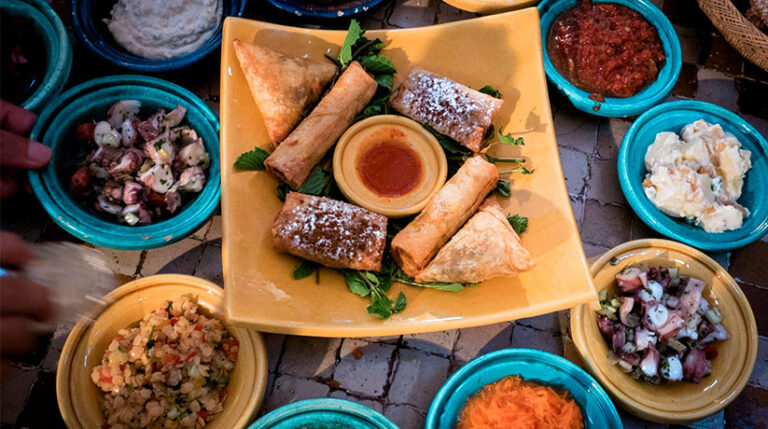
This guide sheds light on the top places to visit in Morocco, showcasing the country’s most iconic destinations. Readers will discover the vibrant heart of Marrakesh, explore the timeless beauty of Fez, and venture into the Sahara Desert near Merzouga. The journey continues to the coastal charm of Essaouira and the majestic Atlas Mountains.
By these highlighting diverse locations, travelers can plan an unforgettable Moroccan adventure that encompasses the country’s rich cultural heritage, stunning natural wonders, and warm hospitality.
Marrakesh: The Red City’s Vibrant Heart
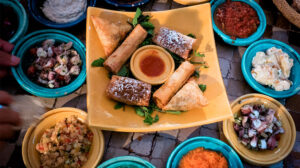
Marrakesh, the vibrant jewel of Morocco, captivates visitors with its rich history, stunning architecture, and bustling atmosphere. Founded in 1070 by the Almoravids, this ancient city has served as the imperial capital for various dynasties throughout its nearly thousand-year history 1. The distinctive red earth used in its construction has earned Marrakesh the nickname “The Red City” 1.
Marrakesh’s Rich History
The city’s history is a tapestry of political struggles, military conflicts, and periods of great splendor 1. Under the Saadians in the 16th century, Marrakesh reached its zenith, with the rulers embarking on ambitious construction projects to rival the grandeur of Ottoman Constantinople 1. The city’s layout still reflects its origins, with the sprawling medieval urban center evoking a sense of desert life 1.
Marrakesh’s Must-Visit Attractions
At the heart of Marrakesh lies the medina, a UNESCO World Heritage site since 1985 2. This ancient quarter is a maze of narrow streets and vibrant souks, offering a glimpse into the city’s rich cultural heritage 3. The iconic Jamaa el-Fna square serves as the pulsating center of the medina, where visitors can experience the city’s lively atmosphere and street entertainment 3.
One of the city’s most recognizable landmarks is the 12th-century Kutubiyyah (Koutoubia) Mosque, with its impressive 253-foot (77-meter) minaret 2. The mosque stands as a testament to the city’s architectural prowess and religious significance. Another must-visit attraction is the Bahia Palace, a 19th-century masterpiece showcasing intricate Moroccan craftsmanship 3.
For a tranquil escape, visitors can explore the Jardin Majorelle, a botanical haven featuring exotic plants and serene water features 3. This garden, once owned by fashion designer Yves Saint Laurent, offers a perfect setting for a leisurely stroll and photography enthusiasts 3.
Marrakesh’s Culinary Delights
Marrakesh’s culinary scene is as vibrant and diverse as its history. The city offers a kaleidoscope of flavors, aromas, and culinary experiences that awaken the senses 4. From street food stalls to fine dining establishments, Marrakesh caters to all tastes and preferences.
One of the city’s culinary highlights is the traditional tagine, a slow-cooked stew prepared in a conical earthenware pot 4. Another must-try dish is pastilla, a unique sweet and savory pastry that perfectly encapsulates the complexity of Moroccan cuisine 4.
For those seeking an authentic experience, a food tour through the medina can provide insight into local specialties such as msemen (Moroccan pancakes) and chebakia (deep-fried pastry dipped in honey) 4. The tour also offers the opportunity to sample a variety of olives and purchase local spices 4.
To complement the food, visitors should not miss the chance to try Moroccan mint tea, an integral part of the city’s culinary and social culture 4. This refreshing beverage is often served in traditional teahouses and cafes throughout Marrakesh.
Chefchaouen: The Blue Pearl of Morocco
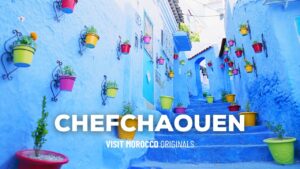
Nestled in the Rif mountains of northern Morocco, Chefchaouen stands out as a captivating destination known for its distinctive blue-washed buildings. This enchanting city, often referred to as “the Blue Pearl” of Morocco, offers visitors a unique visual experience with its azure streets and sapphire-hued architecture 5.
Chefchaouen’s Unique Blue Architecture
The city’s signature blue color scheme dates back to the 1930s when Jewish refugees, fleeing Hitler’s growing influence, settled in Chefchaouen. They introduced the practice of painting buildings blue, a color that holds significant meaning in Judaism. The blue hue symbolizes divinity, faith, wisdom, and truth, serving as a reminder of the sky and, by extension, God’s power 6.
Today, the local government maintains this tradition by distributing paintbrushes every spring, encouraging residents to refresh the blue wash on their homes and alleys 6. The result is a mesmerizing labyrinth of blue-tinted streets, where every turn reveals a new shade of azure or cobalt 5.
Fez: A Journey Through Time
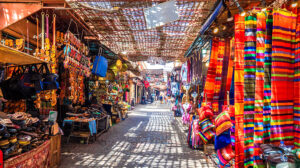
Fez, founded in the 9th century, stands as a testament to Morocco’s rich history and cultural heritage. This ancient city, often considered the spiritual heartland of the country, offers visitors a unique glimpse into the past while showcasing the enduring traditions that have shaped Moroccan society for centuries 7.
Fez’ Historic Medina
At the heart of Fez lies its medina, Fez al-Bali, a UNESCO World Heritage site that has remained largely unchanged for over a millennium 8. This labyrinthine old town, with its narrow streets and alleys, houses a myriad of historic buildings, souks, and residential areas. The medina reached its zenith under Marinid rule in the 13th-14th centuries when Fez replaced Marrakesh as the kingdom’s capital 8.
The medina’s urban fabric is a living museum, featuring numerous monumental buildings that date back to this golden age. Visitors can explore madrasas, fondouks (traditional inns), palaces, residences, mosques, and fountains, each telling a story of the city’s illustrious past 8. The architecture of Fez showcases a unique blend of construction techniques and decorative styles developed over more than ten centuries, incorporating influences from Andalusian, Oriental, and African cultures 8.
Fez’ Traditional Crafts
Fez has long been renowned as a center of craftsmanship, with many of its traditional arts and crafts originating in the city 9. The medina brims with artisans practicing age-old techniques passed down through generations, creating a wide range of exquisite products 9.
One of the most iconic crafts of Fez is its distinctive pottery, known for its blue and white colors, particularly the cobalt blue that has become a hallmark of Fez ceramics 9. The city, along with Meknes and Safi, is responsible for approximately 80% of Morocco’s pottery production 9.
Another notable craft is the creation of zellige, the intricate tile work that adorns many of Fez’ buildings. This art form, introduced by Moors fleeing Andalusia, showcases geometric patterns that require exceptional skill and precision to produce 9.
Fez’ Religious Landmarks
Fez boasts several significant religious landmarks that highlight its importance as a spiritual center. The Qarawiyyin Mosque and University, founded in 859 AD, is considered one of the oldest continuously operating universities in the world 10. This institution played a crucial role in establishing Fez as a leading center of learning in the Islamic world 10.
The Zaouia of Moulay Idriss II, dedicated to the city’s founder, is another important religious site. Built in the 9th century and reconstructed in 1720, it houses a mosque and the tomb of Moulay Idriss II, who is revered as Fez’ patron saint 10.
The Bou Inania Madrasa, constructed between 1350 and 1357, stands out as a remarkable example of Marinid architecture. Unlike most madrasas, it functions as a complete mosque, featuring intricate zellij tile-work, carved stucco, and cedar-wood decorations that exemplify the city’s artistic prowess 10.
Merzouga: Gateway to the Sahara
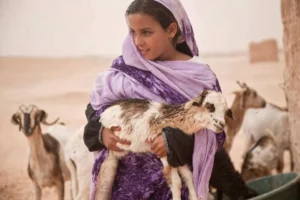
Merzouga, a small village in southeastern Morocco, serves as the gateway to the majestic Sahara Desert. This enchanting destination offers visitors a unique blend of natural wonders, thrilling adventures, and rich cultural experiences. Nestled at the edge of Erg Chebbi, one of Morocco’s two Saharan ergs, Merzouga provides an ideal base for exploring the mesmerizing desert landscape.
Merzouga’s Desert Experiences
The Sahara Desert around Merzouga offers a plethora of exciting activities for adventure seekers. Visitors can embark on camel treks, often referred to as “ships of the desert,” to traverse the undulating sand dunes and enjoy breathtaking views from atop the golden waves 5. For those seeking a more adrenaline-pumping experience, quad biking and dune buggy tours provide an exhilarating way to explore the desert terrain 2.
Many tour operators in Merzouga offer customized desert excursions, allowing visitors to tailor their Saharan adventure to their preferences. These experiences can range from short trips lasting a few hours to multi-day expeditions deep into the heart of the desert 2. Overnight stays in desert camps are particularly popular, offering guests the chance to sleep under the star-studded Saharan sky and witness stunning sunrises and sunsets over the dunes 4.
Merzouga’s Berber Culture
The Merzouga region is home to Berber communities, also known as Amazigh, who have inhabited North Africa for millennia. These indigenous people have a rich cultural heritage that visitors can experience during their stay in Merzouga. The Berbers are known for their hospitality, traditional arts, and unique customs 11.
Berber music plays a significant role in local culture, with instruments like the ginbri (a three-stringed lute) and bendir (a frame drum) often featured in performances 11. Visitors may have the opportunity to witness traditional Berber weddings, which are joyous three-day celebrations filled with singing, dancing, and feasting 12.
Merzouga’s Natural Wonders
Beyond the iconic sand dunes, Merzouga boasts other natural attractions that showcase the diverse beauty of the desert ecosystem. One such wonder is the presence of oases, where clean water flows through waterways amidst the sand dunes, creating pockets of lush vegetation 5. These oases serve as vital lifelines in the arid desert environment and offer a stark contrast to the surrounding landscape.
The region also experiences seasonal phenomena that add to its allure. During certain times of the year, visitors may witness the blooming of almond trees, creating a picturesque scene against the backdrop of the desert 4. Additionally, the area around Merzouga is known for its rich birdlife, attracting ornithologists and nature enthusiasts from around the world.
Merzouga’s unique position as a gateway to the Sahara, combined with its blend of adventure, culture, and natural beauty, makes it an essential stop on any Moroccan itinerary. Whether riding camels across the dunes, experiencing Berber hospitality, or marveling at the desert’s ever-changing landscapes, Merzouga offers unforgettable experiences that capture the essence of Morocco’s diverse attractions.
Essaouira: Coastal Charm and Artistic Flair
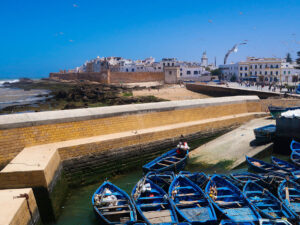
Perched on Morocco’s Atlantic coast, Essaouira captivates visitors with its unique blend of seaside allure and artistic heritage. This UNESCO World Heritage site, formerly known as Mogador, stands as an exceptional example of a late-18th-century fortified town, built according to European military architecture principles in a North African context 13.
Essaouira’s Seaside Attractions
Essaouira’s expansive beach is a major draw for tourists and locals alike. The golden sands stretch along the coast, offering a perfect playground for families and adventure seekers. Water sports enthusiasts flock to Essaouira for its ideal conditions for surfing, kitesurfing, and windsurfing 14. The town’s nickname, the “Windy City of Africa,” hints at the Atlantic breeze that makes it a paradise for these activities.
For those seeking a more relaxed beach experience, the shoreline provides an excellent spot for long strolls and sunset watching. As the sun dips into the Atlantic Ocean, the sky transforms into a canvas of orange hues, creating a magical atmosphere enhanced by the silhouettes of seagulls and the distant call to prayer 14.
Essaouira’s Artistic Heritage
Essaouira has earned a reputation as a city of art and artists, attracting creative minds from various backgrounds. The town’s unique light, colors, and relaxed atmosphere have inspired both local and international artists for generations 15. Since the late 1980s, Essaouira has become something of an artistic mecca, with its popularity solidified by the efforts of Frederic Damgaard, a Danish Islamic art enthusiast 15.
The medina of Essaouira resembles an open-air museum, with art boutiques and galleries scattered throughout its winding streets. Local artisans and artists often display their works along the pavements, creating an immersive artistic experience for visitors 15. Two prominent artistic styles dominate Essaouira’s art scene: the Naive Style and Calligraphy.
The Naive Style, characterized by broad brush strokes and rich colors, often incorporates Gnaoua Sufi imagery. Artists like Ali Maimoun and Mohammed Tabal create vibrant paintings depicting daily life, festival scenes, and ritual nights 15. Calligraphy, inspired by Arabic and Berber scripts, is another popular artistic form, with notable artists like Mohammed Zouzaf and Mohammed Tifardine creating elegant pieces that showcase the beauty of written language 15.
Essaouira’s Culinary Scene
Essaouira’s culinary offerings reflect its coastal location and multicultural heritage. The town is renowned for its fresh seafood, with the port area serving as a hub for fish and seafood lovers. Visitors can purchase directly from fishmongers and have their selections cooked at nearby restaurants 14.
The town’s French influence is evident in its patisseries and creperies, which dot the medina and offer a delightful contrast to traditional Moroccan fare. Around Moulay Hassan Square, a European ambiance prevails, with restaurants spilling onto the pavement and street musicians providing entertainment 14.
Essaouira’s culinary scene also boasts unique local specialties. The region is famous for its argan oil, used both as a beauty product and in cooking. Its nutty flavor adds a distinctive touch to many dishes 16. During the winter months of January and February, visitors can enjoy an abundance of fresh strawberries sold from carts along the main avenues 16.
Conclusion
Morocco’s diverse attractions offer a captivating journey through history, culture, and natural beauty. From the bustling medinas of Marrakesh and Fez to the tranquil blue streets of Chefchaouen, each destination showcases a unique facet of this enchanting country. The coastal charm of Essaouira and the desert wonders of Merzouga further highlight Morocco’s varied landscapes, providing travelers with unforgettable experiences.
This guide aims to inspire visitors to explore Morocco’s rich heritage and breathtaking scenery. By delving into these top destinations, travelers can immerse themselves in the country’s vibrant traditions, savor its culinary delights, and witness its stunning architectural marvels. Morocco’s warm hospitality and blend of ancient customs with modern influences make it a must-visit destination for those seeking an enriching and diverse travel experience.
FAQs
What is the most recommended area to visit in Morocco?
Marrakech is often the first choice for many travelers exploring Morocco. This vibrant and colorful city provides a perfect blend of traditional and modern elements. One of its highlights is the Djemaa el Fna Square, bustling with snake charmers, fortune tellers, and various street vendors.
Where can one find the most stunning scenery in Morocco?
Morocco is home to several breathtaking locations:
- Marrakech : A must-visit vibrant city known for its rich culture.
- Essaouira : Known for its beautiful coastal views and artistic vibe.
- Chefchaouen : Famous for its picturesque blue streets.
- Merzouga and the Sahara Desert : Offers incredible desert landscapes.
- High Atlas Mountains : Ideal for trekking and natural vistas.
- Fez , Tangier , and Asilah also provide unique cultural and historical experiences.
Which location attracts the most tourists in Morocco?
Marrakech is the most popular tourist destination in Morocco, renowned for its vibrant atmosphere and rich cultural heritage. Other highly visited places include Tangier, Rabat, Agadir, Essaouira, Taghazout, Tetouan, and Chefchaouen, each offering unique attractions and experiences.
What are the essential experiences not to be missed in Morocco?
When visiting Morocco, make sure not to miss these captivating sites and experiences:
- Oudaias Kasbah in Rabat, known for its stunning views.
- The Medina in Marrakech , a vibrant and historic market area.
- Toubkal National Park , for its natural beauty and trekking opportunities.
- Jebel Saghro and Erg Chebbi Dunes , for dramatic desert landscapes.
- Fez El Bali , showcasing rich history and traditional crafts.
- Asilah and Chefchaouen , each known for their unique charm and cultural significance.


